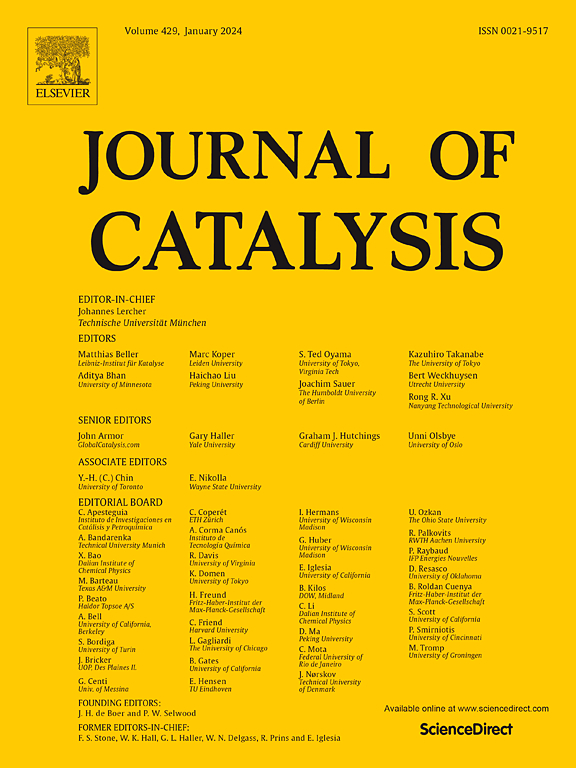Synthesis of a heterogeneous 2D COF-based Fenton catalyst for epoxidation of olefins
IF 6.5
1区 化学
Q2 CHEMISTRY, PHYSICAL
引用次数: 0
Abstract
Styrene oxide is an important intermediate in many chemical syntheses. It can be produced through the epoxidation of styrene using supported metal catalysts. However, the catalytic performance and stability of these catalysts are negatively affected by the mass transfer, diffusional limitations and leaching of metals from supports. In this work, a hydroxyl-substituted bidentate 2D Schiff-base COF supported Fe3O4 particles catalyst (Fe-COF) is developed for styrene epoxidation using H2O2 as oxidant. Fe-COF catalyst possesses an eclipsed layered-sheet structure with a uniform distribution of Fe3O4 particles. Supported Fe3O4 particles as the active sites are responsible for the adsorption of styrene and generation of reactive oxygen radicals through the Fenton process. The presence of the extensive π-electron delocalization effect over COF support facilitates the electron transfer between Fe2+ and Fe3+ sites on Fe-COF catalyst during the reaction, accelerating the Fenton process, thus Fe-COF catalyst even shows a higher catalytic activity (86.0 % conversion of styrene and 88.0 % selectivity to styrene oxide) compared with homogeneous Fenton catalyst (Fe(NO3)3). In addition, Fe-COF catalyst demonstrates good stability after 5 recycles without Fe leaching, due to the coordination of Fe3O4 particles with the imine and hydroxyl groups in COF support.

烯烃环氧化非均相二维cof基Fenton催化剂的合成
氧化苯乙烯是许多化学合成中的重要中间体。它可以通过使用负载金属催化剂将苯乙烯环氧化来生产。然而,这些催化剂的催化性能和稳定性受到传质、扩散限制和金属从载体中浸出的负面影响。本研究以H2O2为氧化剂,制备了一种羟基取代双齿状二维席夫碱COF负载Fe3O4颗粒催化剂(Fe-COF)。Fe-COF催化剂具有重叠层片状结构,Fe3O4颗粒分布均匀。负载型Fe3O4颗粒作为活性位点,通过Fenton法吸附苯乙烯并生成活性氧自由基。COF载体上广泛的π-电子离域效应的存在促进了Fe-COF催化剂上Fe2+和Fe3+位点之间的电子转移,加速了Fenton反应过程,因此与均相Fenton催化剂(Fe(NO3)3)相比,Fe-COF催化剂表现出更高的催化活性(苯乙烯转化率为86.0 %,苯乙烯氧化物选择性为88.0 %)。此外,Fe-COF催化剂在5次循环后没有Fe浸出,表现出良好的稳定性,这是由于Fe3O4颗粒与COF载体中的亚胺和羟基配位。
本文章由计算机程序翻译,如有差异,请以英文原文为准。
求助全文
约1分钟内获得全文
求助全文
来源期刊

Journal of Catalysis
工程技术-工程:化工
CiteScore
12.30
自引率
5.50%
发文量
447
审稿时长
31 days
期刊介绍:
The Journal of Catalysis publishes scholarly articles on both heterogeneous and homogeneous catalysis, covering a wide range of chemical transformations. These include various types of catalysis, such as those mediated by photons, plasmons, and electrons. The focus of the studies is to understand the relationship between catalytic function and the underlying chemical properties of surfaces and metal complexes.
The articles in the journal offer innovative concepts and explore the synthesis and kinetics of inorganic solids and homogeneous complexes. Furthermore, they discuss spectroscopic techniques for characterizing catalysts, investigate the interaction of probes and reacting species with catalysts, and employ theoretical methods.
The research presented in the journal should have direct relevance to the field of catalytic processes, addressing either fundamental aspects or applications of catalysis.
 求助内容:
求助内容: 应助结果提醒方式:
应助结果提醒方式:


